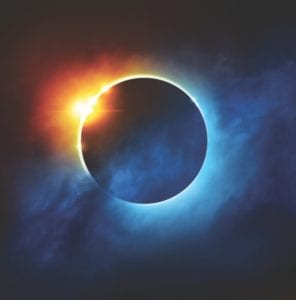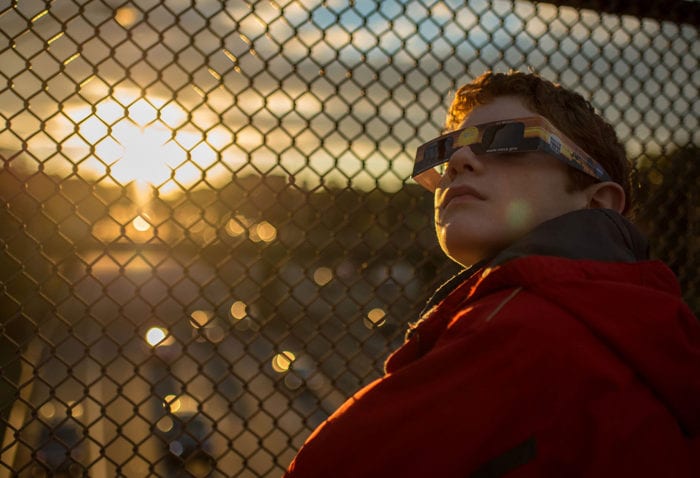By Jill Webb
It won’t be an average Monday, Aug. 21, this year as the moon will completely block the sun for two-and-a-half minutes.
The day marks the first total solar eclipse to happen in North America since 1979, and it’s the first one to stretch from coast to coast in 99 years. In a total solar eclipse the disk of the moon seems to entirely cover the disk of the sun. This will happen Monday on a path about 70 miles wide.

Unfortunately, Long Island isn’t on the eclipse’s path of totality, but you still will be able to see a partial eclipse. New York will have about 71 percent of the sun covered during the eclipse. At 1:24 p.m. the eclipse begins on Long Island, and will last till 4:01 p.m. The peak eclipse time is 2:46 p.m.
“I think it’s wonderful for families to experience this with their children,” NASA expert Laurie Cantillo said. “It could be an experience like this that will get a child to stop looking at a phone or tablet and look up to the sky and perhaps motivate them to want to learn more.”
Fredrick Walters, an astronomy professor at Stony Brook University, has put together a list of ways to maximize your viewing experience of the eclipse. Walters said to focus on looking at the stars emerging during the daytime, the shadow bands that will appear across the land and the changing colors as the light fades.
Most importantly, you need to have the proper viewing tool: eclipse glasses. Regular sunglasses won’t cut it, and it’s very dangerous to directly expose your eyes to the sun.
“We’ve all been taught ever since we were kids don’t ever look directly at the sun and that advice applies,” Cantillo said. “The only time it’s safe to remove eclipse glasses is if you’re in the path of totality, during those couple minutes of totality.”
Unprotected viewing may not cause immediate pain, but Walters said he has heard of cases of people waking up the next morning with blurry vision or blindness. Some people can recover in months to years, but it’s not worth the risk.
North Shore solar eclipse events
Middle Country Public Library
2017 Solar Eclipse: Celestial Event of the Century
At its Centereach building, the library will be hosting a solar eclipse viewing between 1:15 and 3:45 p.m. Along with the viewing, activities and eclipse glasses will be provided for all ages. Register for the event by calling 631-585-9393.
Huntington Public Library
Astronomy Crafts
From noon to 2:00 p.m. Huntington Public Library will be offering an astronomy craft session at its main building as well as the Huntington Station branch. One of the space-themed crafts is an eclipse on a stick. There will also be a viewing event in the afternoon at both buildings where you will receive a free pair of eclipse glasses; no registration is required. For more information, visit www.thehuntingtonlibrary.org.
Long Island Science Center
Solar Eclipse Event
From 1 to 4 p.m. the Long Island Science Center will be hosting solar activities, live streaming and more. Planetarium presentations will happen at 1, 2 and 3 p.m. Admission is $10 and free for children 2 and under. For more information, visit www.lisciencecenter.org.
North Shore Public Library
Catch the Eclipse!
At 1:30 p.m. Tom Madigan of Suffolk County Community College, who is a part of Astronomy for Change, will give a brief presentation on solar eclipses before leading the event outside to view the solar eclipse. Eclipse glasses will be provided. Register for the event by calling 631-929-4488.
South Huntington Public Library
See the Solar Eclipse
Bring some snacks and a blanket to lay out on the lawn behind the library from 1:30 to 3:30 p.m. to witness the eclipse. The library will provide glasses (four per family) while supplies last. Inside, the eclipse will be live streamed from NASA in the library’s theater. Visit www.shpl.info for more information.
Maritime Explorium
Totality 2017 Solar Eclipse
Become a citizen scientist at the Maritime Explorium in Port Jefferson by attending a viewing from 1:30 to 3:30 p.m. and helping to crowd source data for researchers at NASA and EclipseMob. Eclipse glasses will be available while supplies last; no registration required. For more information, visit www.maritimeexplorium.org.
The professor said that these special glasses are basically pieces of Mylar foil shielding your eyes. The glasses should be from proper sources that are certified by testing organizations.
“If you have a pair of eclipse glasses and want to test them, put them on and look —not at the sun — but just look at bright lights and things.” Walters said. “If you can see anything, throw them away. You shouldn’t be able to see [anything] except the sun.”
If you can’t get a pair of eclipse glasses in time, you can DIY them by putting a small round hole in an index card and project the image of the sun onto a flat surface.
“One thing you will notice if you don’t look at the sun through your glasses is if you look at the shadows on the ground, you’ll see the shadows are crescent-shaped,” Walters said.
Leaves in the trees could act as projection tools too, casting multiple tiny crescent-shaped shadows on the ground.
During the partial phase, according to Walters, you won’t notice anything besides the sun getting dimmer.
“Unless, you look at the sun through your eclipse glasses, and you can see the sun is no longer circular — there’s a chunk taken out of it,” Walters said. “But, nothing much changes until you have the total phase of the eclipse because the sun just fades.”
Viewers along the path of totality will have a different viewing experience than Long Islanders.
“Inside the path of totality is completely different, it will be night for two and a half minutes.,” Walters said. “The sun gets completely blocked out, the corona of the sun is about as bright as the full moon, that will provide illumination.”
Walters also pointed out that in the path of totality, regular colors might appear different. Where sunrises and sunsets usually appear to have reddish tints, during the eclipse the tone will have a blue tinge. Another thing to notice is temperature; during the peak eclipse things will get colder.
Eclipses have provided researchers with data to uncover scientific discoveries. This time, the scientists are letting the public partake in their findings.
“One of the things that is being planned for next Monday is the National Solar Observatory and the National Science Foundation have handed out a number of telescopes [and] cameras to people along the eclipse line,” Walters said. “The idea is to have them take pictures and movies and stitch it all together to a 90-minute-long movie of how the sun’s corona is changing. This has never been done.”
If you miss this eclipse, don’t fret because another one is coming April 8, 2024, that will run from Texas through Maine — and upstate New York will be in the path of totality.
“It’s almost a mystical experience — you really have to experience this,” Walters said. “It’s good scientifically, but it’s really a great thing to observe on a human level.”
News 12 meteorologist Rich Hoffman said in an email that the weather forecast for Aug. 21 is good, even though things could change between press time and the eclipse. Hoffman said mostly sunny skies are expected for the day with temperature highs near 84.





